Understanding Area: A Guide for Young Learners
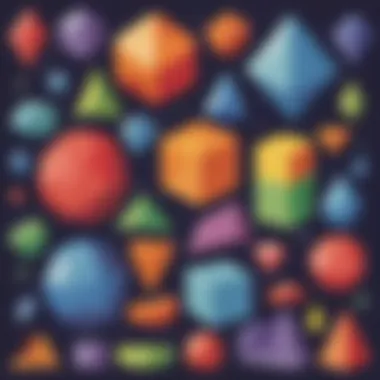
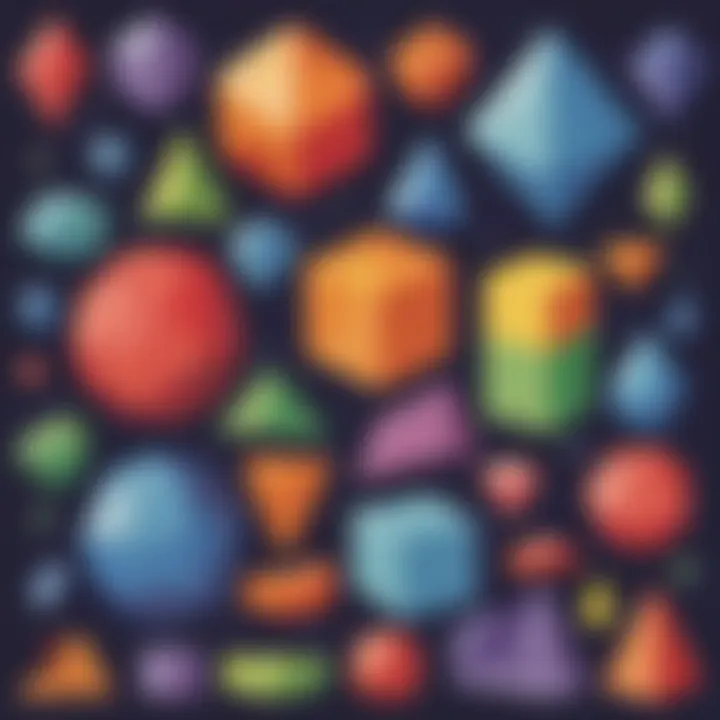
Intro
When we walk around every day, we’re surrounded by shapes. From the school building to park benches, understanding these shapes helps us in so many ways. Have you ever wondered why knowing about area matters? Well, knowing how much space something takes up is pretty key. It’s not just math; it helps us in real life! In this guide, we’re going to break down the concept of area, explore different shapes, and learn some easy methods to calculate it. So, roll up your sleeves and get ready to dive in!
Creative Activities
The best way to learn about area is by doing some fun and crafty activities. Here’s a list of creative projects that can make understanding areas easier and enjoyable.
Craft Ideas
- Shape Collages: Cut different shapes from colored paper. Stick them together to create your own masterpiece! Count the area by finding the area of each shape and adding them up.
- Shadow Art: Take objects from around your home and trace their shadows on paper. Compare the different areas of the objects traced to see which covers more space.
- Outdoor Measurements: Go outside with a measuring tape. Measure different areas in your yard or park. You can draw conclusions about which has the largest area and why it might matter.
Step-by-Step Guides
- Shape Collages
- Shadow Art
- Outdoor Measurements
- Gather materials: paper, scissors, glue, and colored pens.
- Cut out different shapes such as squares, rectangles, and circles.
- Glue the shapes on a larger piece of paper in a creative design.
- Finally, calculate the area of each shape, writing it beside the shape.
- Choose interesting objects from around your home.
- On a sunny day, set them outside and trace their shadows on a piece of paper.
- Measure the traced shapes and calculate their respective areas.
- Take your measuring tape and select a few locations to measure.
- Write down the measurements you take such as length and width.
- Calculate the area for each by using the formula Area = Length x Width.
Educational Value
Engaging in these activities can make the concept of area stick better. It turns a potentially tricky concept into tangible experiences. Kids learn not just with their minds but with their hands too! Crafting encourages creativity while reinforcing important mathematical skills.
Fun Quizzes
Keeping track of what you learn can require a little fun! Quizzes can help test your knowledge in an enjoyable way.
Quiz Topics
- Understanding different shapes and their properties
- Calculating area for squares, rectangles, and circles
- Real-life applications of area in daily situations
Question Types
- Multiple-choice: Choose the correct answer from the given options.
- True or False: Determine if the statements about area are correct.
- Fill in the blanks: Complete sentences with the proper terms related to area.
Knowledge Reinforcement
Participating in quizzes not only makes learning fun but also ensures that kids can recall the information more easily. The variety of question types caters to different learning styles, making it easy for everyone to engage and succeed!
Fact-Based Articles
For those who thirst for more knowledge, there are many interesting fact-based articles that explore area in-depth.
Topics
- The historical importance of area measurement
- How area plays a role in architecture
- Variations in area calculation methods across cultures
Engaging Content
These articles are written in a way that's easy to digest, full of fun facts and visuals that spark curiosity. Simple language helps ensure that even younger kids can follow along and understand.
Preface to Area
Understanding area goes beyond just a mere calculation; it's like finding the full story behind the shapes that surround us every day. At its core, the concept of area helps us to grasp how much space an object occupies. It’s particularly important for elementary students to get a solid hold on this idea because it lays the groundwork for more complex mathematical concepts in the future.
When students learn about area, they're not just counting squares on a piece of paper. They are diving into the wonderful world of geometry where shapes like rectangles, circles, and triangles have their own distinct personalities and uses. The ability to calculate area connects to many real-life situations. For instance, when a child helps in deciding how much paint is needed to cover a wall or how many tiles are required for their bathroom– it’s all about understanding area.
Moreover, grasping this concept encourages curiosity and critical thinking. It can spark questions like, "Why do we need to know this?" or "How does this relate to what I see around me?" These are essential pathways to deeper understanding and learning.
A thorough comprehension of area enables students to make informed decisions in everyday life, building a bridge between classroom concepts and real-world applications.
"Area is not just about numbers; it’s about understanding space and making sense of the world."
By seeing area as a key component in geometry, students can build stronger problem-solving skills, which will benefit them in various academic pursuits. As we navigate through this guide, we will explore the essential facets of area, illuminating the path for young learners and instilling in them a sense of appreciation for this mathematical concept.
What is Area?
Area refers to the measure of the amount of space a shape covers. Imagine you have a square patio in the backyard. The area tells us how much ground that patio takes up, which can influence things like how much grass you need to cover the part around it.
In simpler terms, we can think of area like laying down tiles on a floor or spreading out a picnic blanket in the park. You want to know how much material you'll need, and that's where area stepping in to lend a helping hand. Each geometric shape has a specific formula that helps us find its area, such as the formula for rectangles, which is length multiplied by width.
Importance of Understanding Area
The significance of understanding area can't be overstated, especially for young minds eager to make sense of the world. Knowing how to calculate area allows students to engage in practical math that extends beyond the classroom.
Here are some reasons why area knowledge is vital:
- Real-life Applications: From determining how much carpet to buy, to figuring out how many seeds to plant in a garden, understanding area is key to making informed decisions.
- Foundation for Advanced Math: A solid grasp of area prepares students for more complex topics in math, including geometry and even algebra.
- Enhances Spatial Awareness: When children learn about area, they develop better spatial thinking. They start to visualize shapes and understand their properties more intuitively.
- Encourages Critical Thinking: Area calculations often require problem-solving skills, which can translate into improved analytical abilities in other subjects too.
Basic Concepts of Geometry
Understanding the fundamental principles of geometry is like having a sturdy map for a journey through the diverse world of shapes and spaces. Knowledge of these basic concepts lays the groundwork for grasping more complex ideas throughout the journey of learning mathematics. At its core, geometry involves the study of shapes, sizes, and the properties of space, making it an invaluable part of mathematics, particularly when it comes to calculating area.
The significance of geometry isn't just about numbers and formulas; it’s about perceiving and interpreting the physical world. When students become familiar with basic geometric concepts, they can begin to visualize objects and areas in their environment. Whether they’re helping measure a room for new furniture or using shapes to craft a simple art project, understanding geometry boosts their problem-solving skills and spatial awareness.
Understanding Shapes
Shapes represent the essence of geometry. They are everywhere we look! From the square windows of a house to the circular wheels of a bicycle, recognizing and categorizing these shapes is much like being an explorer charting unknown territory. Each shape comes with its unique properties and characteristics.
Why Shapes Matter:
- Identifying Shapes: Children learn to distinguish between two-dimensional shapes like squares, circles, and triangles, which helps them categorize the world around them.
- Properties of Shapes: Each shape has defining features, such as the number of sides or angles, which ultimately leads to understanding how to calculate area.
- Applying Shapes: Knowing shapes is vital for real-life applications, such as calculating the area of a garden bed or understanding design in architecture.
Take triangles, for example. They can be found in art, nature, and even the structures we build. Understanding how different shapes come together is crucial for grasping broader mathematical concepts.
Types of Geometric Figures
Geometric figures can be categorized into several types, and knowing these categories helps students visualize and organize their thoughts. Here are some major types:
- Polygons: These figures have straight sides and can be simple, like triangles and quadrilaterals, or complex, like nonagons.
- Circles: A circle is a special shape where every point is the same distance from the center. Knowing how circles work is essential, especially when exploring areas.
- Three-Dimensional Shapes: Unlike flat shapes, these have depth. Examples include cubes and spheres. Little ones often find these more relatable, as they link to everyday objects like boxes and balls.
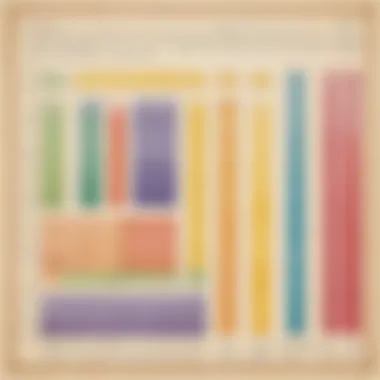
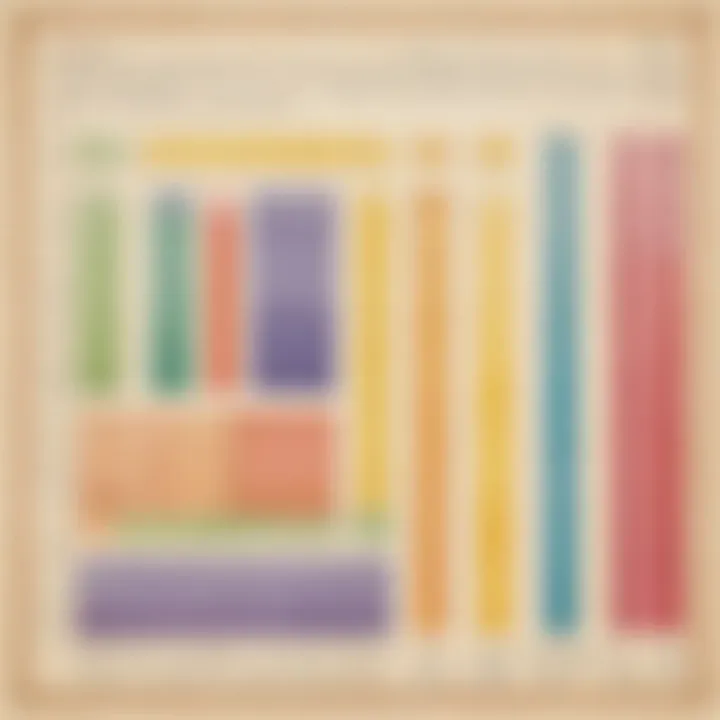
Recognizing these types of shapes not only aids in calculating area but also enhances overall mathematical literacy. A solid understanding ensures children are equipped to tackle areas, both in their studies and daily life.
Learning about these basic principles of geometry is like assembling pieces of a puzzle. Each shape brings its own attributes to the table, and when put together, they create a full picture of mathematical understanding. As they grasp the importance of shapes and figures, students open the door to more advanced geometry concepts, ensuring their growth in the discipline.
"Geometry is the art of correct reasoning from incorrectly drawn figures." – Henri Poincaré
Calculating Area of Rectangles
Calculating the area of rectangles is a fundamental aspect of understanding geometry that every student will encounter. It's a stepping stone, a vital skill that serves multiple purposes not just in math class, but in everyday life. Recognizing the rectangular shapes around us—doors, windows, and even screens—underlines why learning to find their area is important. This skill helps students grasp how space is utilized, providing insight into measurements and dimensions that are useful in various real-world applications.
By mastering this concept, young learners develop critical thinking abilities and practical problem-solving skills that extend beyond textbooks. When we talk about rectangles, we’re not only discussing shapes; we’re exploring a basic yet significant component of environmental understanding that young minds can build upon as they progress in their education.
Formula for Area of a Rectangle
The formula for calculating the area of a rectangle is straightforward:
Area = Length × Width
Here’s how it works. If you know the length of a rectangle, which is how long it is, and the width, which is how wide it is, simply multiply these two measurements. For example, if a playground is 10 meters long and 5 meters wide, the area can be calculated like this:
- Length = 10 meters
- Width = 5 meters
Area = 10 meters × 5 meters = 50 square meters
This tells you how much space is available on the playground, quite handy for planning activities or placing equipment.
It’s neat how simple multiplication can reveal so much about the world around us!
Real-world Applications
The practical applications of calculating the area of rectangles are plenty. Let’s dive into a few of them:
- Home Renovations: When planning to put new tiles in a bathroom, knowing the area of the floor helps in estimating how many tiles are needed.
- Gardening: If you want to plant flowers in a rectangular garden bed, calculating the area allows you to determine how many plants can fit.
- Shopping for Furniture: When buying a new couch, you’ll want to measure the living room floor space to ensure it fits nicely.
- Packaging: Understanding the area of rectangular boxes helps businesses to design packaging that fits their products safely and efficiently.
"Measuring area is a skill that can lead to practical solutions in our everyday lives."
So, next time you see a rectangle, whether it’s in your classroom or in your backyard, remember that knowing how to find its area is not just math; it’s a useful tool that helps us navigate through various situations like a pro.
Calculating Area of Squares
Understanding how to calculate the area of squares is an essential aspect of geometry that can be useful in both academic settings and everyday life. Squares are one of the simplest shapes that you will encounter, making it vital for young learners to grasp the concepts surrounding their area. Once students learn how to find the area of a square, it becomes a stepping stone to understanding more complex shapes in the geometry world.
In practical terms, the area of a square is a fundamental building block in various real-life applications. From understanding how much paint is needed to cover a wall squared up in your house to determining how much flooring you'll need to install, the square's area calculation finds use in countless tasks. This also plays a key role in teaching critical reasoning skills, as students will learn to approach calculations in a methodical way.
Square Area Formula
The formula to calculate the area of a square is quite straightforward. It is given by:
Area = side × side
or simply:
Area = side²
This means that if you know the length of one side of the square, you multiply that value by itself to find the area. For example, if a square has a side length of 4 units, the area calculation would be:
Area = 4 × 4 = 16 square units.
It’s as simple as pie!
Usually, students can visualize this better if they think of it in terms of counting the squares in a grid. If you lay out 4 squares in a row for the length and 4 squares in a column for the height, you end up with a total of 16 smaller squares inside the larger square.
Common Uses of Squares
Squares pop up in all sorts of places, and recognizing their uses helps students connect geometry to real life. Let's look at a few common examples:
- Tile Design: Think about the tiles in your bathroom or kitchen. Each tile is usually square. Knowing the area of a tile helps in figuring out how many tiles will be needed to cover a floor or a backsplash.
- Gardening: When planning a garden, each section might be laid out in squares. Knowing the area helps gardeners determine how many plants can fit in their designated planting space.
- Packing: If you're packing boxes for moving, knowing the area of the base can help you determine how much stuff you can fit inside.
- Art Projects: When cutting out shapes for crafts or school projects, students can also use area calculations to ensure they have enough material to fit their design.
"Understanding area opens doors to problem-solving skills that are useful throughout life."
Learning to calculate the area of squares is just the beginning. Emphasizing real-world applications can spark curiosity and give context to what might seem like an abstract math concept. By mastering this fundamental aspect of geometry, students can build a strong foundation for future math challenges.
Exploring the Area of Triangles
Understanding triangles is a fundamental part of grasping geometry, and knowing how to calculate their area opens up a treasure chest of real-world applications. Triangles are unique shapes with different characteristics, and every type—be it equilateral, isosceles, or scalene—presents its own charm. This section illuminates the significance of learning about triangle area, especially for young learners. Among many benefits, mastering this concept fosters creativity in problem-solving and enhances visual spatial awareness.
Triangle Area Formula
To find the area of a triangle, the classic formula is:
Area = (base × height) / 2
This formula shows that the area of a triangle is half the product of its base and height. Now, the base is any side of the triangle, but you must measure the height perpendicularly from a vertex down to the chosen base.
Here’s a little breakdown:
- The base: it can be any one of the three sides.
- The height: this is a line that hits the base perfectly at a right angle.
Simply plug in the values you get from measuring, and voilà! You just calculated the area. Here’s an example to make it even clearer: If a triangle has a base of 4 cm and a height of 3 cm, then the area would be (4 × 3) / 2 = 6 cm².
Applications in Real Life
Triangles aren't just shapes in textbooks; they show up in various places in our daily lives. Knowing how to calculate the area of a triangle can enhance practical skills. Here are some neat instances:
- Architecture and Design: When an architect designs a roof, they often use triangular sections. Calculating the area makes sure that enough materials are used, which saves money and resources.
- Art Projects: If kids want to make a banner in the shape of a triangle, they need to know how much paint or fabric to use. Calculating the area helps them figure out the right amount required for their project.
- Sports: Consider a triangular court used for badminton or a small soccer field; understanding the area helps players know how much space they’re dealing with.
- Nature: Take a look at this: mountains can often form triangular peaks, and learning about their area helps scientists study the landscapes and ecosystems.
Understanding Circles and Their Area
Circles are everywhere in our world — from the wheels on our bikes to the round pizzas we eat, understanding the area of a circle can be very practical. This section dives into the nature of circles, emphasizing how knowing about their area opens up a whole new realm of understanding for young learners. Grasping the concept behind circular shapes not only enriches their mathematical skills but also provides insights into the environment around them.
Calculating Area of a Circle
To find the area of a circle, we use a simple but powerful formula: A = πr², where A stands for area, π (pi) is roughly 3.14, and r is the radius of the circle — the distance from the center to the edge.
Let's break this down with an example. Imagine you have a round garden with a radius of 3 meters. To find the area, you would square the radius (3 × 3 = 9) and then multiply it by π (approximately 3.14). This gives:
[ A = 3.14 \times 9 = 28.26 \text square meters ]
So, the area of this garden is 28.26 square meters. That's how much space is inside that circle! Understanding how to calculate this aids in grasping other kinds of surface spaces where circles appear.
Significance of Circular Shapes
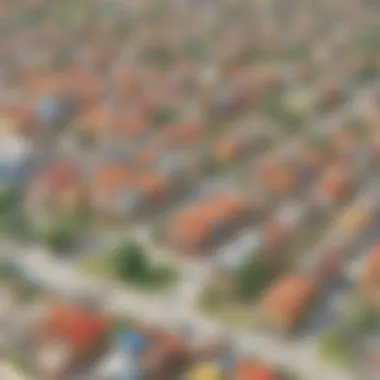
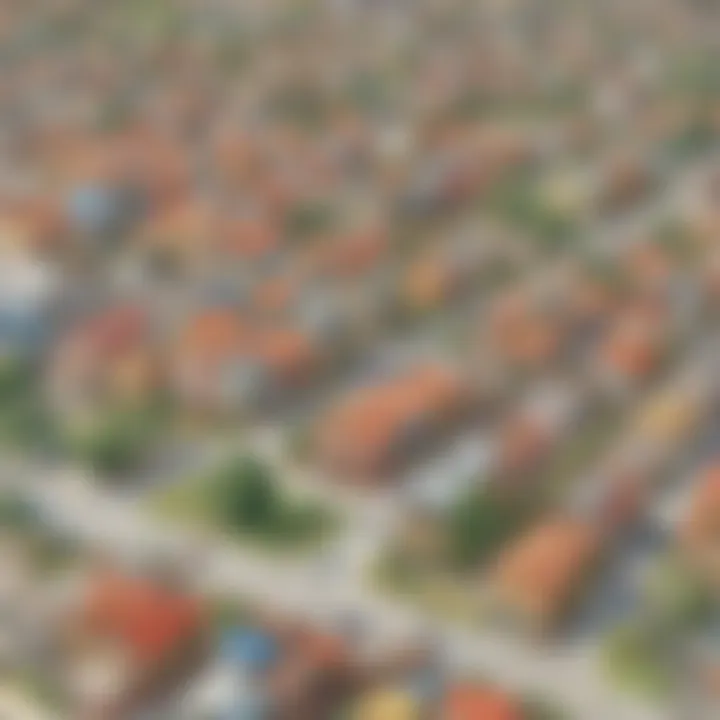
Now that we know how to calculate area, let’s talk about why circles matter. Circular shapes are significant in both nature and technology. They embody balance and symmetry, seen in objects like wheels, frisbees, and even bubbles. These shapes are synonymous with efficiency; for instance, a round pizza allows for even baking as heat circulates uniformly.
- Design: In engineering, round components can reduce friction and wear, making machines more efficient.
- Nature: Many natural phenomena, like the orbits of planets, are circular, showcasing the fundamental role circles play in physics.
- Art: Artists often use circular forms to create visually captivating pieces.
"Understanding circles enriches our perspective on both the natural and designed world around us."
By recognizing the significance of circles, students can foster a more profound appreciation of mathematics beyond just numbers and formulas. This, in turn, can help spark interest in further exploration within geometry and its application in real-life scenarios.
Understanding the area of circles thus not only enhances mathematical skills but also provides a gateway into more complex geometrical concepts as students progress in their learning journey.
Area of Composite Shapes
Understanding the area of composite shapes is like piecing together a puzzle. Each part contributes to the whole, and knowing how to tackle these familiar objects can make a complex calculation much simpler. This section equips young learners with intuitive strategies, ensuring that they can navigate shapes made up of different figures. Learning about composite shapes also enhances problem-solving skills and encourages critical thinking—a true victory in math!
Breaking Down Composite Shapes
To begin with, it’s crucial to break down a composite shape into its simpler, individual components. Picture a rectangular park that has a circular fountain at one end; to determine the entire area, you should identify the rectangle and the circle separately first. Here’s how you can think through it:
- Identify Shapes: Look at the composite shape and figure out what basic shapes it comprises. Is it made up of rectangles, triangles, circles, or a combination of these?
- Measure Dimensions: For every identified shape, gather the relevant measurements. This could mean finding the length and width for rectangles, or the radius for circles.
- Use Formulas: Now that the shapes are identified and measured, apply the right formulas. For example:
- Area of a rectangle = Length × Width
- Area of a circle = π × (Radius)²
For a practical exercise, let’s say there is a playground that is a rectangle with a semicircular slide attached at one end. First, calculate the area of the rectangle, then the semicircle. Add these two areas together to find the total area of the playground.
This method not only helps in visualizing the problem but also builds a solid foundation for more complex geometrical concepts down the road.
Combining Areas for Total Calculation
Once the areas of individual shapes have been calculated, the next step is combining those areas. Think of it like gathering all the ingredients to bake a cake; each amount matters so the final product turns out right. Here’s a step-by-step guide:
- Sum the Areas: After calculating, it’s time to add those areas together. If the area of the rectangle in our playground example is 50 square meters and the area of the semicircle is 25 square meters, simply sum those results:
- Check Your Work: Double-check the measurements and calculations before concluding. Missteps can happen, especially when juggling multiple numbers.
- Understand Practicality: Knowing how to find the total area of composite shapes is not just a math exercise; it's essential in real-world applications. Architects, landscapers, and even game designers utilize this skill.
- Total Area = Area of Rectangle + Area of Semicircle = 50 m² + 25 m² = 75 m².
By mastering the combination of areas, elementary students will gain confidence in their mathematical abilities, making geometry feel like a natural part of their everyday decisions.
"Mathematics is not about numbers, equations, or algorithms: it is about understanding."
Engaging exercises that challenge students to identify, break down, and combine areas of composite shapes can significantly boost their comprehension. Platforms like Wikipedia or Britannica can provide further examples and resources for those eager to learn more.
Measuring Area in Different Units
Understanding area is not just about knowing how large a space is; it also requires knowing how to express that size in different units. Measuring area in different units is crucial because it helps us apply our knowledge of area in various real-world contexts. Whether you’re calculating the space for a new rug, determining how much paint is needed to cover a wall, or even figuring out how big a garden can be, knowing how to measure area accurately is of utmost importance.
Standard Units of Area
To make sense of area, we often use standard units that simplify our calculations and comparisons. The most common unit of area in the metric system is the square meter. Here are a few examples of standard units of area:
- Square Centimeters (cm²): Used for smaller areas, like a sheet of paper.
- Square Meters (m²): Commonly used for rooms and larger spaces.
- Hectares: This unit is often used to measure land (1 hectare is 10,000 m²).
- Acres: Mostly seen in real estate, especially in countries like the United States.
These different units of area serve distinct purposes and contexts. For example, if you want to measure your bedroom, you would probably use square meters. However, if you are looking at a large park, acres or hectares would be more logical. Using the right unit helps avoid confusion and ensures that measurements are meaningful.
Converting Between Units
Converting between these units is something that might sound tricky but can be straightforward when approached step-by-step. Here’s how you can go about it:
- Identify the Units: Know what units you’re starting with and what you want to convert it to.
- Use Conversion Factors: A conversion factor is a number that you multiply by to get from one unit to another. For example:
- Double-check Your Work: It’s always a good idea to recheck your calculations to make sure you haven’t made any slips.
- To convert square meters to square centimeters, you multiply by 10,000 (since 1 m² = 10,000 cm²).
- Conversely, to go from square centimeters to square meters, you would divide by 10,000.
For example, if you have a room that is 25 square meters and you want to know how many square centimeters that is, you simply multiply:
Doing this not only helps in comparing sizes effectively but also aids in practical situations when making decisions about materials or spaces.
"Understanding the units of area allows us to make sense of the spaces around us and how we can utilize them effectively."
In essence, mastering these different units and how to switch between them opens up a whole new world of possibilities for problem-solving and applied mathematics in daily life.
Practical Exercises for Understanding Area
When it comes to understanding area, practical exercises play a vital role in making the concepts stick. Engaging in hands-on activities allows students to apply what they've learned in a tangible way. These exercises not only promote retention but also build confidence in math skills. Let's delve deeper into how these practical experiences can help solidify the understanding of area.
Hands-On Area Projects
Hands-on area projects are an exciting way for students to explore area in real-life applications. For example, consider a project where students create a garden layout. They can draw a scaled plan on graph paper and calculate the area needed for each section, like flowers or vegetables. This project does more than just teach area; it encourages planning, creativity, and organization. Here are some ideas for hands-on area projects:
- Creating a Scale Model: Use cardboard or paper to construct scale models of different geometric shapes. Measure the dimensions, calculate the areas, and display the results.
- School Yard Measurement: Take a tape measure and go outside to measure areas around the school grounds, such as the playground or sports field. Students can then calculate the total area.
- Art and Geometry: Encourage students to create a piece of art that incorporates different geometric shapes, calculate the area of each shape used, and present to the class.
These projects not only make learning about area enjoyable but also emphasize real-world contexts where area is important.
Interactive Online Area Games
In the digital age, interactive online games provide another great way to bridge learning and fun. These games can reinforce area concepts in a playful atmosphere. For instance, websites offer math games tailored for elementary students, where they can solve area-related puzzles or play challenging quizzes.
Some recommended features of online games include:
- Instant Feedback: Many games provide immediate feedback to students, helping them understand mistakes in real-time and improve.
- Progress Tracking: Kids can see their progress, motivating them to improve their skills further.
- Variety of Activities: From shape identification to area calculations, a variety of interactive tasks keeps the learning fresh and engaging.
Games such as "Area Adventure" or "Shapes and Spaces" allow students to navigate challenges while learning to calculate area through trial and error. Furthermore, the social aspect of many online platforms encourages collaboration among peers, which can enhance the learning experience.
"Letting students engage actively with concepts is key to understanding. Practical exercises provide them the chance to grasp abstract ideas in meaningful ways."
By blending hands-on projects and interactive online games, students can enjoy a well-rounded learning experience. Such practical exercises are fundamental for grasping the principles of area and how they relate to the world around. With each project and game, students build a stronger foundation in mathematics, preparing them to tackle more advanced topics in geometry.
Visual Aids for Understanding Area
In the journey of learning about area, visual aids play a critical role. They help transform abstract concepts into something tangible and relatable. For elementary students, understanding area is not just about numbers or formulas—it is about seeing how these concepts fit into the real world. Visual tools, such as graphs and geometry software, greatly enhance this understanding by bridging the gap between theory and practice.
One of the key benefits of visual aids in geometry is that they cater to different learning styles. Some kids learn better through seeing rather than just hearing or reading explanations. By using images, diagrams, and interactive tools, educators can engage students in a more meaningful way. Consideration must also be given to the complexity of the visuals used—keeping things straightforward will prevent confusion and keep students focused on the central idea of area.
"Visual aids can turn learning from a chore into an exciting adventure!"
Using Graphs to Illustrate Area
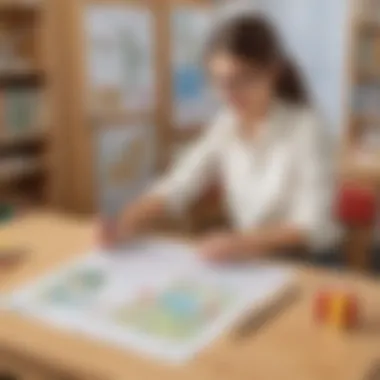
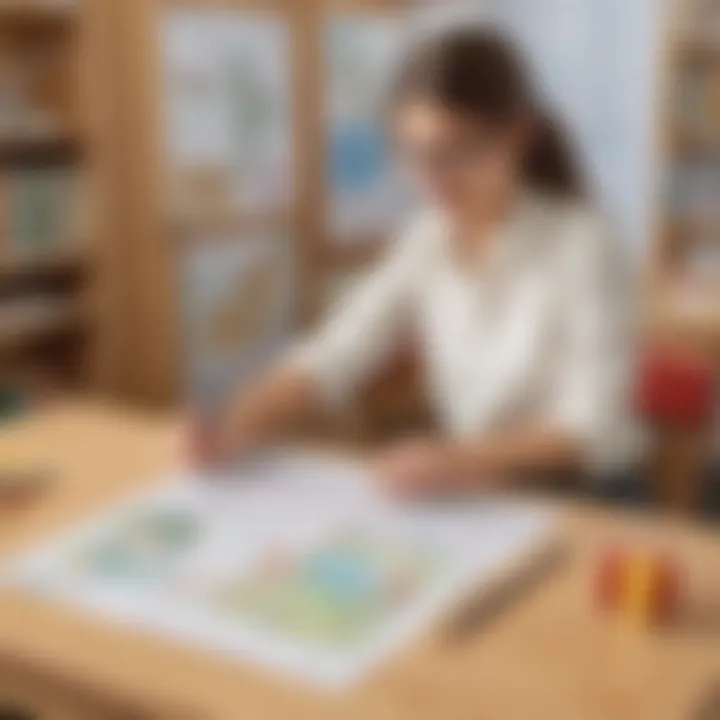
Graphs are a powerful means of representation that can simplify the process of calculating area. When students learn to plot shapes on a grid, they can directly visualize how area relates to the units within that grid. This hands-on experience solidifies their conceptual understanding. For instance, if students are working with rectangles, plotting these shapes on graph paper allows them to count the squares within the shape to find the area.
- Graphs provide a clear, visual way of understanding how area works.
- They help facilitate discussions about the dimensions of shapes and their impacts on total area.
- Using grid paper, children can experiment with shapes of different sizes and orientations to see how area changes and remains consistent.
Geometry Software Tools
In today's digital age, geometry software tools have become invaluable for teaching area concepts. Programs such as GeoGebra or SketchUp allow students to manipulate shapes on a screen, providing an interactive learning experience. These tools often feature drag-and-drop functionalities that help students visualize the relationships between different shapes and their areas.
- Interactivity: Kids can modify dimensions and immediately see how the area increases or decreases, enhancing their mathematical intuition.
- Instant Feedback: Many software programs provide quick answers, letting students verify their calculations straight away, reinforcing learning outcomes.
- Accessible Resources: Numerous online platforms offer tutorials and guided exercises that cater to various learning levels, making these tools accessible for all learners.
Common Misconceptions About Area
Understanding the concept of area is pivotal for elementary students, especially given the various misconceptions that can arise as they learn about geometry. Misunderstandings not only cloud the true meaning of area, but can also lead to mistakes in mathematical problem-solving down the line. By clearing up these common misconceptions, students can build a solid foundation in mathematics that will benefit them in future learning.
Distinguishing Area from Perimeter
One of the most frequent misunderstandings is confusing area with perimeter. Area refers to the space contained within a shape, while perimeter measures the distance around that shape. It's essential for students to grasp that although both terms involve measurements, they serve different purposes and contexts.
For instance, consider a rectangle that measures 4 units long and 3 units wide. The area can be calculated by multiplying the length by the width: 4 x 3 = 12 square units. This means the rectangle occupies space equal to 12 unit squares. In contrast, when calculating perimeter, students would add the lengths of all sides: 4 + 3 + 4 + 3 = 14 units. The difference in these calculations often trips up young learners.
Key Point: Always remember: Area is about the inside, while perimeter counts the outsides!
Myths Surrounding Area Calculation
Another area of confusion stems from various myths about area calculations. One common myth that floats around is that only rectangles and squares can have area. This simply isn’t true. All shapes have area, including circles and triangles, and it’s crucial for students to understand that regardless of the shape, area can be calculated.
Often, students may believe that larger shapes inherently have a larger area, without considering their dimensions. For example, a long, skinny rectangle may have a larger area than a smaller, more square-like shape. It's beneficial to present various shapes and dimensions through visual aids so that students can see how dimensions can influence area in unexpected ways.
When teaching area calculations, highlighting these myths can foster curiosity and engagement. Encourage students to question their assumptions and explore the realm of geometry with an open mind.
To sum up, addressing misconceptions is a vital step in developing a robust understanding of area. By clarifying the distinction between area and perimeter, and dismantling common myths, students will not only enhance their mathematical skills but also build confidence as they explore the world of geometry.
Area in Everyday Life
Understanding area goes beyond classrooms and textbooks; it’s a concept that’s everywhere in our daily lives. Even if kids don’t realize it, whether they’re playing, cooking, or helping in the garden, they're constantly using their knowledge about area. Recognizing how area impacts everyday tasks can make learning more engaging and applicable.
Real-world Applications of Area
When students learn about area, it offers them practical insights into how geometry fits into real life. Here are various ways area is used in everyday situations:
- Gardening: Imagine planting flowers. Measuring the garden’s area helps in deciding how many plants can fit in that space. Knowing that a square meter can hold about five seedlings can be a big help.
- Home Improvement Projects: When a family decides to paint a room or lay down new flooring, they need to know the area of the walls or the floor. This way, they can buy just enough paint or tiles, saving money and reducing waste.
- Cooking: A chef needs to understand the area of a pan. A larger area means more surface for sautéing vegetables. For instance, knowing how many square inches of space a frying pan provides can determine how many servings can be cooked at once.
- Sports: On a basketball court, the area determines how much space players have to move around. Understanding this allows coaches to devise strategies that make the best use of space.
Making Sense of Area in Nature
Nature is full of shapes and spaces, making it a great teacher about area. As kids explore the natural world, they can connect their experiences with the concept of area:
- Landscapes: Observing park maps helps kids visualize how much area different parks cover. They might learn how large their local park is compared to others.
- Animal Habitats: Many animals require specific areas to live and thrive. Birds, for example, may need certain square footage in trees or shrubs for nesting. Understanding these spaces can help children appreciate wildlife conservation.
- Water Bodies: When kids think about lakes and ponds, they begin to grasp the scale of areas as well. Knowing the area of a lake can show how big it actually is, affecting ecosystem health and local activities like fishing.
Getting to grips with area in one’s surroundings creates a bridge between mathematics and the real world. By relating these lessons to things they see and do every day, kids are naturally more inclined to engage with and remember this important concept. The realization that area isn't just a mathematical term but is relevant in countless scenarios can enhance their appreciation for geometry.
Impact of Area Knowledge on Problem-Solving
Understanding area plays a significant role in sharpening problem-solving skills, especially for elementary students. Grasping how to calculate area allows children to approach various challenges with a better sense of spatial reasoning. It empowers them to think critically about their environment and enhances their ability to find solutions in real-world scenarios.
For example, when students learn how to measure the area of a room, they not only understand basic math but also apply it to real life. If a child wants to place a rug in their bedroom, knowing the room’s area helps them choose the correct size rug. This skill translates into better planning and decision-making in everyday tasks, making area knowledge practically useful.
Critical Thinking Through Area Calculations
When students start working with area calculations, they are presented with numerous opportunities to strengthen their critical thinking skills.
- Analyzing Shapes: They learn to analyze different shapes and their properties, figuring out how these attributes influence their area.
- Problem Breakdown: Learning to break down complex shapes into simpler ones (like dividing a rectangle into two squares) encourages logical reasoning.
- Creative Solutions: Faced with a problem, students may have to devise various methods to find the area, which nurtures creativity and flexibility in thinking.
Thus, examining area relates math to logic and reasoning. It challenges students, encouraging them to explore and evaluate different paths to find an answer, which is predominantly valuable in both academic and everyday settings.
Developing Spatial Awareness
Area knowledge contributes significantly to spatial awareness, which is crucial as children grow and encounter more complex tasks. Students develop a clearer understanding of how objects fit and interact within their surroundings.
- Visualizing Space: By calculating areas of different objects, children can better visualize the space around them. For instance, when determining how much space a garden will take up, they consider not just the area but also how it integrates with other elements in the yard.
- Understanding Dimensions: Learning about area helps students comprehend how dimensions work. Whether it's the length of a room or the width of a piece of paper, knowing how to quantify spaces aids them in planning and design activities.
- Real-world Applications: This spatial awareness springs to life in daily life, from arranging furniture to solving problems in art projects. The capacity to visualize shapes and their areas leads to enhanced problem-solving abilities, making students more competent in navigating their world.
"Math is not just about numbers, equations, or algorithms; it's about understanding the world around us."
Future Learning in Geometry
Understanding the concept of area lays a strong foundation for future learning in geometry. Once students grasp the basics of how to measure the space within various shapes, they can apply these principles to more complicated forms and real-world scenarios. This section highlights the importance of continuing this mathematical journey beyond elementary education.
Advanced Shapes and Their Areas
As young learners progress, they will encounter more complex geometric shapes than the usual squares, rectangles, and triangles. Advanced shapes like hexagons, octagons, and even more intricate polygons will come into view.
- Area Calculation for Polygons: Learning how to determine the area of these shapes involves a few steps, often requiring students to break them down into smaller, more manageable parts. For instance, a hexagon can be divided into triangles or rectangles, making it easier to compute the total area.
- Real-Life Applications: Understanding these advanced shapes can open up a realm of discovery regarding architecture and nature. Take honeycombs, for example. Their hexagonal shape maximizes space efficiency while using minimal material. Knowing how to calculate the area of these shapes can have real implications in engineering and design.
"Geometry isn't just what you do in the classroom; it's all around you, just waiting to be uncovered!"
Areas in Three-Dimensional Shapes
Moving beyond two-dimensional figures, area learning transitions into three dimensions. In order to understand three-dimensional shapes like cubes, spheres, and pyramids, learners need to consider both surface area and volume.
- Surface Area vs. Volume: Both concepts are vital. Surface area refers to the total area covering the surface of a three-dimensional object. Volume, on the other hand, measures how much space the object occupies inside. This distinction is essential and helps students appreciate the complexity of geometric relationships.
- Applications in Different Fields: In real life, knowledge about the surface area and volume is crucial in fields like manufacturing, shipping, and even cooking. For example, when building a box to store items, knowing the surface area helps in deciding how much material is needed, while volume helps in determining what can fit inside.
Culmination
Understanding area is essential for students as they navigate the world of geometry. This concluding section ties together all the important concepts covered in the article, reinforcing why knowing about area matters. Having a grasp of area provides the foundation necessary for students to approach more complex mathematical challenges later in their education. It’s not just about numbers on a page; it’s about visualizing the space around us.
Recap of Area Principles
To summarize, area is a measure of the space a shape occupies. Each shape has its own specific formula - whether it's rectangles, squares, triangles, or circles. The formula for a rectangle, for instance, is width multiplied by height.
- Rectangle: Area = Width × Height
- Square: Area = Side × Side
- Triangle: Area = 1/2 × Base × Height
- Circle: Area = π × Radius²
This knowledge helps students understand how to calculate the area of various shapes. Beyond formulas, recognizing how to apply them practically is crucial. From laying out a garden to figuring out how much paint is needed for a room, area helps us in our daily lives.
"A solid understanding of area turns theoretical geometry into practical skills that students can use wherever they go."
Encouragement for Further Exploration
It is important to inspire curiosity in students regarding area and geometry. After mastering the basics, they can explore more advanced concepts. Encourage them to look into:
- Real-life applications: From architecture to art, the principles of area are everywhere.
- Different shapes: Explore irregular shapes and how to calculate their areas using decomposition methods.
- Outdoor adventures: Measuring the area of a playground or garden allows for hands-on learning.
- Technology: Show them geometry software or interactive games where they can visualize and calculate areas.
By fostering this exploratory spirit, students become invested in their learning, transforming abstract ideas into tangible understandings. The journey through geometry does not end with this guide – rather, it opens the door to a world of mathematical discovery that awaits them.







